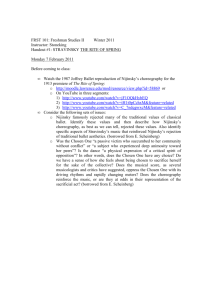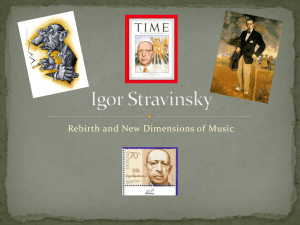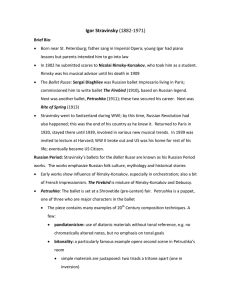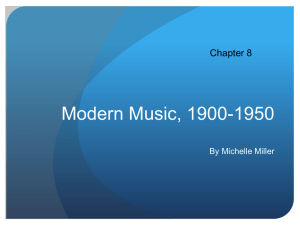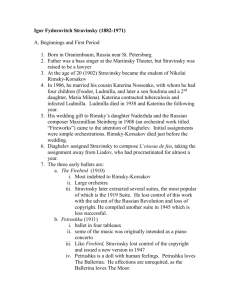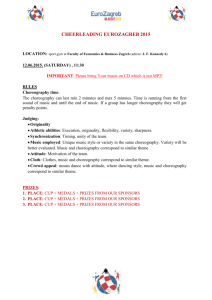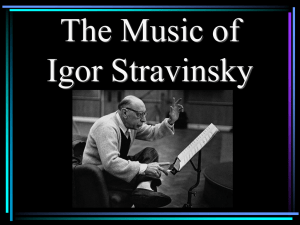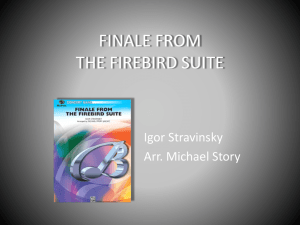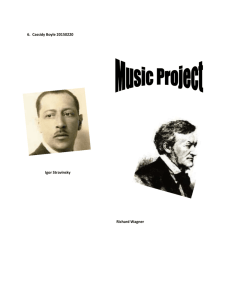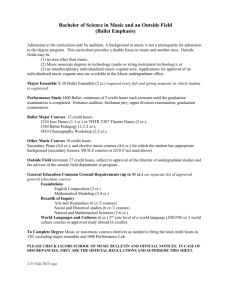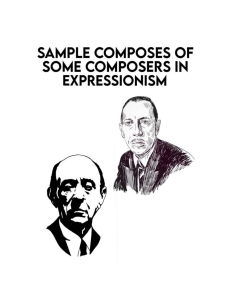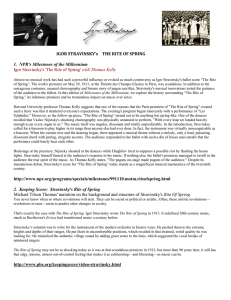The Rite of Spring
advertisement
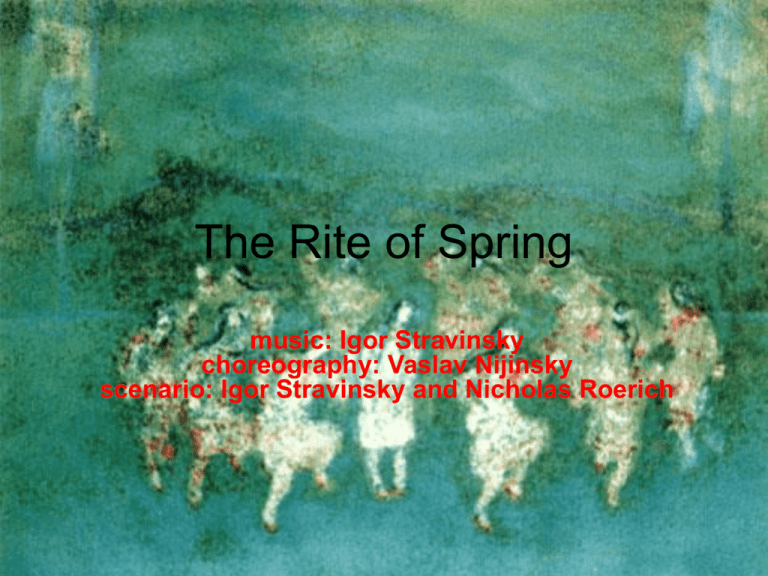
The Rite of Spring music: Igor Stravinsky choreography: Vaslav Nijinsky scenario: Igor Stravinsky and Nicholas Roerich Initial Commission • To construct a ballet that recreates the terror experienced by ancient Slavs during a pagan sacrificial rite that takes place to ensure the fertility of the land and of the tribe The Chosen • Envisioning a primitive society of the far Russian steppes involved in ritual sacrifice, Stravinsky worked with set and costume designer Nicholas Roerich. Nicholas Roerich • The work was composed between 1911 and 1913 for Sergei Diaghilev’s Ballets Russes. Synopsis • The two act ballet portrays a tribe through several scenes with processions of maidens, elders, a centuries-old female diviner, a Sage and the Chosen One, who is plucked from the young women and dances to death for the sake of communal continuity. The Chosen Premiere of the Ballet • The Rite of Spring premiered at the Thèâtre des Champs Elysées on May 29, 1913. • As soon as the curtain went up, a riot ensued. Theatre des Champs Elysees Audience Reaction • upset with the subject of barbarism, a subject that the world was not yet ready to deal with • upset that Nijinsky had "turned the conventions of ballet inside out" • upset with Stravinsky’s disregarding the accepted rules of musical composition The Sage Ballet • The choreography boldly dispenses with grace and beauty to emphasize awkward, primitive movement. • The corps de ballet dance on the outer ball of their feet. • Dancers stomp, jump, and shake uncontrollably to express their terror. • One of the dancers recalled that Vaslav Nijinsky's shocking choreography was physically unnatural to perform: "With every leap we landed heavily enough to jar every organ in us." Influences on the Choreography: The Meaning • The pull of the earth is evident in the weighted steps. • Driven purpose and frenzy is expressed in the repetitive and jagged action, with pounding jumps and contorted positions. Influences on the Choreography: The Costumes • The patterns Roerich had hand-painted on the dancers' coarse smocks, in fact, came to influence Nijinsky's choreography. • The choreography mirrored the geometric motifs in circular movements and linear arrangements. The Music—Overview • The music itself is angular, loud, dissonant and totally unpredictable so as to suggest terror. The young maidens The Music—Overview • The music violated all preconceptions of beauty, harmony, tone and rhythmic order that we are familiar with in "music". • Stravinsky's score provides percussive polyrhythms and jarring orchestral colors to create a seemingly primeval experience. In Stravinsky’s own Words “The work’s embryo is a theme that came to me after I had finished The Firebird. As this theme and what followed from it was conceived in a brutal and forthright manner, I took as developmental pretext what that music actually evoked, that is, prehistoric Russia as I, being myself Russian, conceive it. But bear in mind that this idea comes from music, not the music from the idea.” The Shock of the New • harmonically adventurous • emphasis on dissonance used for its own sake • rhythmically harsh, with a number of sections having constantly changing time signatures and unpredictable offbeat accents Pablo Picasso. Portrait of Stravinsky Use of Repetition to Replace Harmonic Progression • Pitted two chords against each other at the same time • Took one dissonant cluster of notes, hammering them over and over until he felt that a change was called for aesthetically • Then another cluster of notes would follow, but in another pitch determined by Stravinsky himself rather than the old laws of sound Use of Harsh Sounds • Loud • Huge orchestra: eight French horns, four trumpets, a piccolo trumpet and a bass trumpet, three trombones, two tubas and large woodwinds, string, and percussion sections. • Strings play “down bow” • Instruments muffled by mutes • Plenty of jarring percussion • Lack of melody • Lack of harmony • Lack of regular rhythms Part I: Adoration of the Earth • • • • • • • • Introduction Dances of the young girls Ritual of abductions Round dance Ritual of the two rival tribes Procession of the oldest and wisest one The kiss of the earth ) The dancing out of the earth Introduction • In the introduction, Stravinsky called for a bassoon to play higher in its range than anyone else had ever done. • This introduction is very folk-like and adapted from a Lithuanian folk song. The Adoration of the Earth • When the curtain rose and the dancing began, there appeared a musical theme without a melody, only a loud, pulsating, dissonant chord with jarring, irregular accents. The Adoration of the Earth • The bassoon solo sets off a series of short, fragmented, repeating solos that begin to overlap and pile up on each other, building up to a controlled chaos that foreshadows some of the real tension to come. Part II: The Sacrifice • Introduction • Mystic circle of the young girls • The naming and honoring of the Chosen One • Evocation of the ancestors (Ancestral Spirits) • Ritual action of the ancestors • Sacrificial Dance (the Chosen One)
